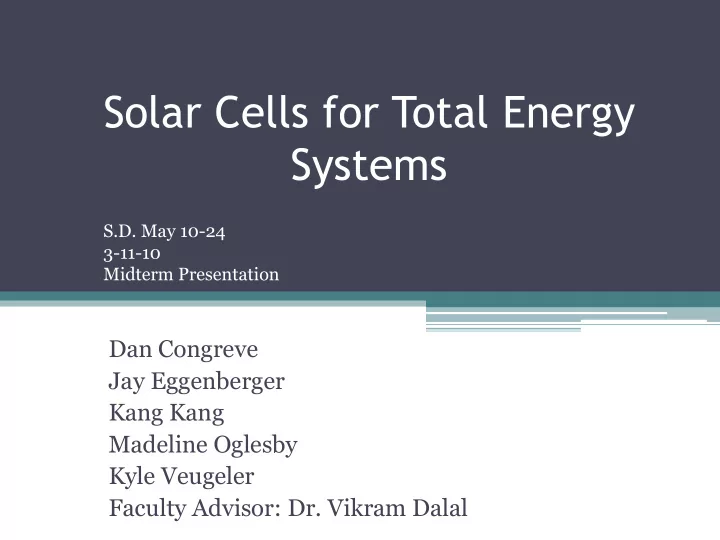

Solar Cells for Total Energy Systems S.D. May 10-24 3-11-10 Midterm Presentation Dan Congreve Jay Eggenberger Kang Kang Madeline Oglesby Kyle Veugeler Faculty Advisor: Dr. Vikram Dalal
Project Plan • Senior design project ▫ Fabricate and test performance of amorphous and nanocrystalline tandem junction solar cells for total energy systems • Solar total energy system ▫ Provide both hot water and electricity from the same panel ▫ The tandem junction design will have increased efficiency at high temperatures (70-80 C) • Deliverables ▫ Fabricated solar cells that meet requirements ▫ Test results that confirm our theory
Project Design • Anti-Reflective Coating ▫ Layer of transparent conductive oxide serving as the top contact ▫ Minimize absorption and reflection losses for incident light of wavelengths 400-1100 nm ▫ Provide good electrical contact while letting most of the incident light pass through solar cell layers • a-Si and nc-Si Thickness ▫ Spectrum Splitting ▫ Current Matching
Semester Progress • Received training on I-V testing • Performing tests to confirm thesis ▫ Show that nc-Si and a-Si perform better than c-Si at high temperatures. • Devices fabricated and tested week of 2/15/10
IV Test Procedures • Lab station calibrated with test cell • Lamp provides illumination of 1 sun • Placed sample solar cell under lamp • Swept open circuit voltage from -0.5 to 1 volt above Voc • Observed Fill Factor, current, and power output of the solar cell • Repeated test results at (25, 50, 75, and 100 Celsius) • Plotted results vs. temperature
I-V Curves vs. T: a-Si (2-12843) I-V Curves for Various Temperatures for a-Si Solar Cell 1.6 1.4 1.2 1 Current (mA) 25 C 0.8 50 C 75 C 0.6 100 C 0.4 0.2 0 0 0.1 0.2 0.3 0.4 0.5 0.6 0.7 0.8 0.9 1 Voltage (V)
I-V Curves vs. T: nc-Si (1-6947) I-V Curves for Various Temperatures for nc-Si Solar Cell 2.5 2 1.5 Current (mA) 25 C 50 C 75 C 1 100 C 0.5 0 0 0.05 0.1 0.15 0.2 0.25 0.3 0.35 0.4 0.45 0.5 Voltage (V)
I-V Curves vs. T: a-Si (2-12921) I-V Curves for 2-12921 a-Si Tandem Cell 0.6 0.5 0.4 Current (mA) 25C 0.3 50C 75C 100C 0.2 0.1 0 0 0.2 0.4 0.6 0.8 1 1.2 1.4 1.6 1.8 Voltage (V)
Future Plans • Begin crystalline I-V testing to establish baseline values • Receive first wave of tandem junction cells and begin I-V testing process • Observe initial data results to determine design efficiency • Begin I-V testing secondary wave of tandem solar cells • Obtain training in Quantum Efficiency testing of cells • Begin QE testing of all tandem junction cell designs • Conclude, compile and analyze all data and findings • Begin creation of senior design informational poster board
Recommend
More recommend